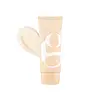What's inside
What's inside
 Key Ingredients
Key Ingredients

 Benefits
Benefits

 Concerns
Concerns

 Ingredients Side-by-side
Ingredients Side-by-side

Water
Skin ConditioningZinc Oxide
Cosmetic ColorantCoco-Caprylate
EmollientCaprylic/Capric Triglyceride
MaskingButyloctyl Salicylate
Skin ConditioningPropanediol
SolventVitis Vinifera Seed Oil
EmollientSodium Stearoyl Glutamate
CleansingCetearyl Alcohol
EmollientArachidyl Alcohol
EmollientTocopherol
AntioxidantCaprylyl Glycol
EmollientCoco-Glucoside
CleansingAstrocaryum Tucuma Seed Butter
EmollientEthyl Ferulate
AntioxidantBehenyl Alcohol
EmollientCetyl Palmitate
EmollientSorbitan Palmitate
EmulsifyingSorbitan Olivate
EmulsifyingArachidyl Glucoside
EmulsifyingSodium Gluconate
Skin ConditioningCitric Acid
BufferingBisabolol
MaskingAcacia Senegal Gum
MaskingCaprylhydroxamic Acid
Glycerin
HumectantXanthan Gum
EmulsifyingAcetyl Glucosamine
Skin ConditioningSodium Hyaluronate
HumectantPolyhydroxystearic Acid
EmulsifyingTetrahexyldecyl Ascorbate
AntioxidantAloe Barbadensis Leaf Juice
Skin ConditioningWater, Zinc Oxide, Coco-Caprylate, Caprylic/Capric Triglyceride, Butyloctyl Salicylate, Propanediol, Vitis Vinifera Seed Oil, Sodium Stearoyl Glutamate, Cetearyl Alcohol, Arachidyl Alcohol, Tocopherol, Caprylyl Glycol, Coco-Glucoside, Astrocaryum Tucuma Seed Butter, Ethyl Ferulate, Behenyl Alcohol, Cetyl Palmitate, Sorbitan Palmitate, Sorbitan Olivate, Arachidyl Glucoside, Sodium Gluconate, Citric Acid, Bisabolol, Acacia Senegal Gum, Caprylhydroxamic Acid, Glycerin, Xanthan Gum, Acetyl Glucosamine, Sodium Hyaluronate, Polyhydroxystearic Acid, Tetrahexyldecyl Ascorbate, Aloe Barbadensis Leaf Juice
Water
Skin ConditioningButyloctyl Salicylate
Skin ConditioningDibutyl Adipate
EmollientEthylhexyl Salicylate
UV AbsorberTitanium Dioxide
Cosmetic ColorantPropanediol
SolventDiethylamino Hydroxybenzoyl Hexyl Benzoate
UV FilterButylene Glycol
HumectantBis-Ethylhexyloxyphenol Methoxyphenyl Triazine
Skin ConditioningC12-15 Alkyl Benzoate
AntimicrobialNiacinamide
SmoothingEthylhexyl Triazone
UV AbsorberPolyglyceryl-2 Stearate
Emulsifying1,2-Hexanediol
Skin ConditioningMethyl Methacrylate Crosspolymer
Glyceryl Stearate
EmollientStearyl Alcohol
EmollientAluminum Hydroxide
EmollientStearic Acid
CleansingSodium Polyacrylate
AbsorbentPolyglyceryl-6 Polyricinoleate
EmulsifyingEthylhexyl Stearate
EmollientBehenyl Alcohol
EmollientVp/Hexadecene Copolymer
Ammonium Acryloyldimethyltaurate/Vp Copolymer
Propolis Extract
Skin ConditioningTriethoxycaprylylsilane
Caprylyl Glycol
EmollientRosa Damascena Flower Water
MaskingMusa Sapientum Fruit Extract
Skin ConditioningOleth-10
EmulsifyingPolysorbate 60
EmulsifyingAdenosine
Skin ConditioningPyrus Malus Stem Extract
Skin ConditioningEthylhexylglycerin
Skin ConditioningTrideceth-6
EmulsifyingXanthan Gum
EmulsifyingMel Extract
MoisturisingPinus Pumila Needle Extract
HumectantOyster Extract
Hc Yellow No. 4
CI 16035
Cosmetic ColorantWater, Butyloctyl Salicylate, Dibutyl Adipate, Ethylhexyl Salicylate, Titanium Dioxide, Propanediol, Diethylamino Hydroxybenzoyl Hexyl Benzoate, Butylene Glycol, Bis-Ethylhexyloxyphenol Methoxyphenyl Triazine, C12-15 Alkyl Benzoate, Niacinamide, Ethylhexyl Triazone, Polyglyceryl-2 Stearate, 1,2-Hexanediol, Methyl Methacrylate Crosspolymer, Glyceryl Stearate, Stearyl Alcohol, Aluminum Hydroxide, Stearic Acid, Sodium Polyacrylate, Polyglyceryl-6 Polyricinoleate, Ethylhexyl Stearate, Behenyl Alcohol, Vp/Hexadecene Copolymer, Ammonium Acryloyldimethyltaurate/Vp Copolymer, Propolis Extract, Triethoxycaprylylsilane, Caprylyl Glycol, Rosa Damascena Flower Water, Musa Sapientum Fruit Extract, Oleth-10, Polysorbate 60, Adenosine, Pyrus Malus Stem Extract, Ethylhexylglycerin, Trideceth-6, Xanthan Gum, Mel Extract, Pinus Pumila Needle Extract, Oyster Extract, Hc Yellow No. 4, CI 16035
 Reviews
Reviews

Ingredients Explained
These ingredients are found in both products.
Ingredients higher up in an ingredient list are typically present in a larger amount.
Behenyl Alcohol is a type of fatty alcohol (these are different from the drying, solvent alcohols).
Fatty Alcohols have hydrating properties and are most often used as an emollient or to thicken a product. They are usually derived from natural fats and oils; behenyl alcohol is derived from the fats of vegetable oils.
Emollients help keep your skin soft and hydrated by creating a film that traps moisture in.
In 2000, Behenyl Alcohol was approved by the US as medicine to reduce the duration of cold sores.
Learn more about Behenyl AlcoholButyloctyl Salicylate is a chemical UV filter structurally similar to octisalate. It is a photostabilizer, SPF booster, emollient and solvent. This ingredient helps evenly spread out ingredients.
According to a manufacturer, it is suitable for pairing with micro Titanium Dioxide, Zinc Oxide, and pigments.
Photostabilizers help stabilize UV-filters and prevents them from degrading quickly.
Learn more about Butyloctyl SalicylateCaprylyl Glycol is a humectant and emollient, meaning it attracts and preserves moisture.
It is a common ingredient in many products, especially those designed to hydrate skin. The primary benefits are retaining moisture, skin softening, and promoting a healthy skin barrier.
Though Caprylyl Glycol is an alcohol derived from fatty acids, it is not the kind that can dry out skin.
This ingredient is also used as a preservative to extend the life of products. It has slight antimicrobial properties.
Learn more about Caprylyl GlycolPropanediol is an all-star ingredient. It softens, hydrates, and smooths the skin.
It’s often used to:
Propanediol is not likely to cause sensitivity and considered safe to use. It is derived from corn or petroleum with a clear color and no scent.
Learn more about PropanediolWater. It's the most common cosmetic ingredient of all. You'll usually see it at the top of ingredient lists, meaning that it makes up the largest part of the product.
So why is it so popular? Water most often acts as a solvent - this means that it helps dissolve other ingredients into the formulation.
You'll also recognize water as that liquid we all need to stay alive. If you see this, drink a glass of water. Stay hydrated!
Learn more about WaterXanthan gum is used as a stabilizer and thickener within cosmetic products. It helps give products a sticky, thick feeling - preventing them from being too runny.
On the technical side of things, xanthan gum is a polysaccharide - a combination consisting of multiple sugar molecules bonded together.
Xanthan gum is a pretty common and great ingredient. It is a natural, non-toxic, non-irritating ingredient that is also commonly used in food products.
Learn more about Xanthan Gum